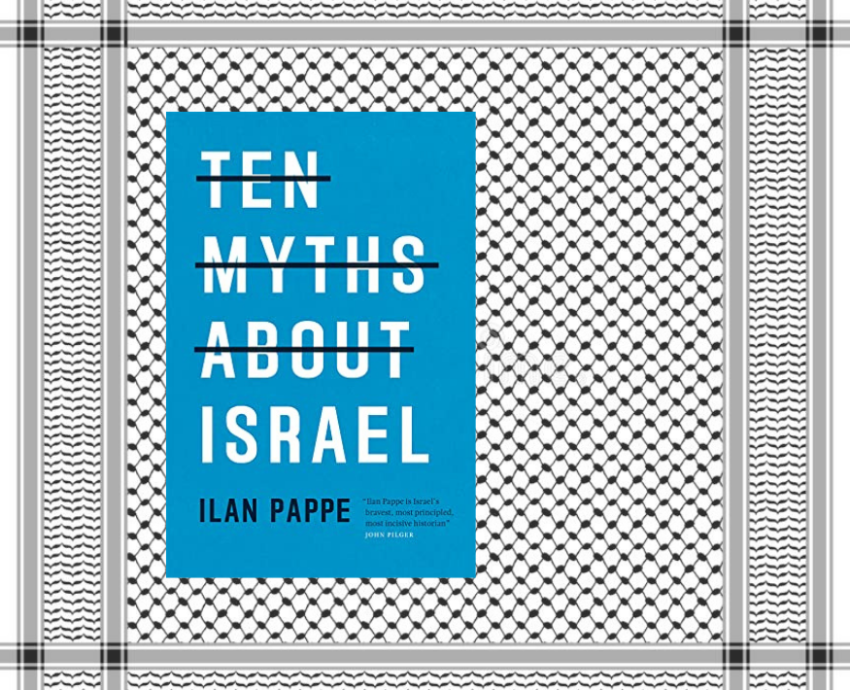
Ten Myths About Israel
By Ilan Pappé
London. Verso Books, 2017. 192 pp.
The Zionist account of Israel is based on a set of core myths that cast doubt upon Palestinian claims to the land.
These myths serve as hasbara, a euphemism for pro-Israeli propaganda. Hasbara often goes unchallenged by the Western media and imperialist states that benefit from the role Israel plays in the Middle East.
Ilan Pappé, author of many books on Palestine, including The Ethnic Cleansing of Palestine and On Palestine with Noam Chomsky, dismantles Israeli hasbara in Ten Myths About Israel.
Pappé is an Israeli historian, socialist and anti-Zionist activist, whose support of the Boycott, Divestment and Sanctions (BDS) campaign lost him his position at Haifa University in 2007.
Pappé tackles each myth in chronological order, from the late 19th century to the present day.
When Jewish settlers arrived in the 19th century, they didn't find a “land without people” or a “desert waiting to bloom”. Palestine was a thriving society, and a vital part of the Eastern Mediterranean, despite being occupied by the Ottoman Turks since 1517.
The majority of the population was either Muslim or Christian, with the indigenous Jewish population making up 2–5%.
The Zionist movement that emerged among secular Jews like Theodor Herzl believed that instead of struggling against anti-Semitism at home, Jews should create a state of their own. Zionists were willing to make alliances with whichever forces would help them achieve their aims.
The Zionist movement’s interests coincided with British Imperialism’s, leading to Zionists supporting Britain during World War I. The British government issued the Balfour Declaration in 1917, supporting the creation of a Jewish state in Palestine.
Statements by Zionist leaders reveal that it has always been a settler-colonial movement, intent on displacing the Palestinian population.
For example, in 1937 Israeli Prime Minister David Ben-Gurion said: “In many parts of the country, it will not be possible to settle without transferring the Arab fellahin [peasants] … With compulsory transfer we would have a vast area for settlement … I support compulsory transfer. I don’t see anything immoral in it.”
Up until World War II, the Zionist movement was a minority among Jewish people in Palestine and elsewhere. Anti-Zionist sentiment was strong among socialist and Orthodox Jewish currents.
With the horrors of the Holocaust fresh in people's memories in 1948, the Zionist movement took the opportunity to implement their planned expulsion of Palestinians.
Pappé debunks the myth that Palestinians left their homes voluntarily, or on orders from Arab military forces. He provides evidence that Zionist leaders had a systematic plan to use terror to expel the Palestinian population. Zionist militias destroyed homes, imprisoned males over 10 years of age, and carried out rapes and a series of massacres, such as at Deir Yassin, a village near Jerusalem.
When Israel defeated the Arabic armies in 1967, another myth perpetuated, saying Israel had no choice but to go to war. Pappé shows that this is false: then-Prime Minister Menachem Begin said, “In June 1967 we again had a choice ... We must be honest with ourselves. We decided to attack them [the Egyptian Army].”
Israel’s victory in 1967 meant it could now occupy the West Bank, Jerusalem and the Gaza Strip, as well as solidify an alliance with the United States.
US support enables Israel to continue its genocidal project with impunity — through the building of settlements in the West Bank, apartheid-style discrimination against non-Jews within the 1948 borders of historic Palestine, and the ongoing bombardment and economic strangulation of Gaza.
Pappé shows that the myth of "no Palestinian partner for peace" is also false. It was the US/Israeli commitment to maintaining Israel’s colonialist settler project that doomed the Oslo and Camp David Accords to failure.
Pappé also rejects the myth of the “two-state solution”, arguing that it reinforces the notion that only Jews can live in a Jewish state and allows Zionists and anti-Semites alike to link Israel with Judaism.
A more just solution, Pappé argues, “lies in the creation of a democratic state that includes all of its inhabitants”.
The year after Ten Myths about Israel’s publication, Israel’s right-wing governing party endorsed a resolution calling for full annexation of the West Bank.
The Israeli war on the Palestinian people continues unabated. The latest attacks claimed the lives of more than 212 civilians, including 61 children.
Ten Myths about Israel is a vital book for anyone interested in debunking Zionist propaganda and achieving justice for Palestine.